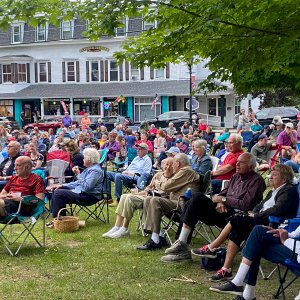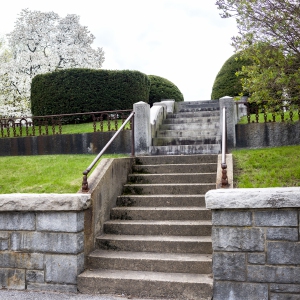Ducks can live in trees
| Published: 05-06-2017 5:01 PM |
It’s May, and my yard is lively with a marathon of nest building.
Bluebirds are stuffing nest boxes with grasses and pine needles; the phoebe has created a cradle of moss in her usual spot under my porch roof; and downy woodpeckers are excavating a hole in a dead maple tree. Nest locations and building techniques vary widely, but in all of these cases the nests are elevated to reduce assault by predators.
Surprisingly, some ducks also use that high-rise strategy. The wood duck and hooded merganser are two native ducks that are cavity nesters, seeking holes in dead trees or utilizing large nesting boxes created by humans in which to lay their eggs.
Both of these species make their homes in wooded swamps, old beaver ponds, marshes or along streams. Like all ducks, they are swimmers and need water to provide safety and food. But unlike most waterfowl which build their nests on the ground, these intriguing paddlers are adapted for spending time in trees.
Wood duck males are strikingly beautiful. A crested iridescent green head is punctuated by red eyes, while his glossy chestnut breast is dotted with white flecks. However, like most female ducks, his mate is much duller. Her body is gray but white spectacles around her eye and streaked breast make her quite distinctive.
These ducks form pair bonds in the fall, migrate north together, and return to the same breeding territory each March or as soon as there is open water.
The female does most of the home inspections, visiting abandoned woodpecker holes or other openings to find one that is suitable. Tree ducks are not able to excavate their own cavity.
An ideal hole is three-and-a-half to four inches in diameter. The hollow may be as deep as two to 15 feet and is from two to 60 feet above the ground. The nest tree may be in the water or near the shoreline but also may be as much as a mile away from water.
Article continues after...
Yesterday's Most Read Articles
 New Hampshire providers brace for Medicaid changes that reach beyond healthcare
New Hampshire providers brace for Medicaid changes that reach beyond healthcare
 New England College expands $10,000-per-year offer to Concord, Bishop Brady graduates
New England College expands $10,000-per-year offer to Concord, Bishop Brady graduates
 Concord school leaders weigh the future of middle school project without state building aid
Concord school leaders weigh the future of middle school project without state building aid
 Truck collision on South Main Street in Concord diverts traffic
Truck collision on South Main Street in Concord diverts traffic
 Warner shot down a housing developer’s bid. New statewide zoning mandates could clear a path for proposals like it.
Warner shot down a housing developer’s bid. New statewide zoning mandates could clear a path for proposals like it.
All of these measurements are just numbers until you realize that young wood ducks must navigate these distances. When they hatch, after about a 30-day incubation period, they are covered with downy feathers but are ready to go. It’s a good thing because their mother doesn’t bring them any food and their father has abandoned them by the fourth week of incubation (not helping in that process at all).
When the ducklings are about two days old, the mother duck exits the nest, flying to the ground nearby.
She makes encouraging “kuk, kuk” sounds to coax them to follow her. One by one each little fuzz ball uses its tiny claws to climb up the walls of the nest toward the circle of light and get its first glimpse of the outside world.
Without much time to enjoy the view (its 11 to 14 siblings are following close behind) the plucky youngster makes a leap of faith, like a sky diver jumping from a plane. But with no parachute and only tiny wings, the ducklings land with a bounce, or perhaps a splash if the nest tree is in the water.
Unharmed, they scurry to join their mother, never to return to their nest.
From then on she shows them what to eat – seeds, fruits, acorns and some insects. Foraging together for several weeks, the ducklings grow and become independent.
After five weeks the female leaves them, though they are not able to fly for another three to four weeks. The mother joins other adult females and goes through a post breeding molt.
This lifestyle may seem a bit harsh but the reproductive success of wood ducks has brought them back from near extinction in the early 1900s. At that time, tree cutting, loss of habitat and market hunting for food and feathers almost wiped them out.
Just as they began to recover, the 1938 hurricane brought down countless nesting trees.
At that point human-made boxes were set out to provide alternative nests. These efforts, coupled with an increase in beavers and the ponds they create, has enabled wood ducks to rebound and become quite common in our region.
Though common, they are secretive and not easy to find, but that makes the reward of a seeing them all the more exciting.
]]>







 Hopkinton art gallery showcases “Creativity Beyond Convention”
Hopkinton art gallery showcases “Creativity Beyond Convention” AROUND CONCORD: Your guide to free summer music
AROUND CONCORD: Your guide to free summer music Around Concord: Steps to nowhere – but it used to be somewhere
Around Concord: Steps to nowhere – but it used to be somewhere Around Concord: Refreshing recipes from Table Bakery
Around Concord: Refreshing recipes from Table Bakery
